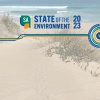EPA Monitor
The EPA Monitor is a monthly newsletter produced by the Strategic Communication and Engagement Branch. Please subscribe to receive regular updates.
2024
State of the Environment Report launched
29/02/2024

The EPA has released its latest 5-yearly State of the Environment Report, making a number of recommendations to help safeguard South Australia’s environment, with a strong focus on climate change and biodiversity losses.
The State of the Environment Report is designed to improve understanding of the environmental challenges and opportunities South Australia faces, and further support the effort towards sustainability.
This year, for the first time, the report has also incorporated the views of Aboriginal peoples as the traditional custodians in protecting and restoring Country, including an expert report and recommendations on how Aboriginal peoples’ cultural perspectives can be more effectively incorporated in the State’s approaches to environmental protection.
Presiding Member of the EPA Board, Cathy Cooper, said the report showed that unless urgent measures are taken, climate emergency and biodiversity losses will become crises for the environment and our communities.
“South Australians can be proud of the work that has been done to help protect and restore our environment,” she said.
“South Australia has taken leadership in reducing greenhouse gas emissions through renewable energy generation, progressing a circular economy through resource recovery and removing a range of plastics from the waste stream.
“Programs have also been implemented to tackle biodiversity loss and improve management of our water resources.
“However, the 2023 State of the Environment Report shows that for some areas, particularly climate change impacts and biodiversity, the trends continue to get worse.“Plans and actions have not delivered improvements at a scale and speed sufficient to address these impacts.”
Ms Cooper said that the State of the Environment Report highlights pressures that have the potential to impact the environment and makes recommendations for action.
“Accountability will be important to ensure actions are resourced, enabled, driven and supported to ensure their implementation,” she said.
“This report is not just for government, but also for industry, communities and individuals so that we can work together to ensure the future and prosperity of our beautiful state, for generations to come.”
The five recommendations from the 2023 report are:
- Taking action: That the South Australian Government develops and implements an overarching framework that contextualises and orients its policies and actions for protecting and restoring the environment, identifying critical priorities based on level of risk and clarifying the relationships and interdependencies between them in delivering co benefits.
- Responding to climate change: That the South Australian Government notes the links and interdependencies between emissions reduction, climate change adaptation and different societal sectors, and tasks relevant agencies with collaborating in risk assessment, response planning and program delivery to capture the benefits of a coordinated approach.
- Biodiversity protection: That the South Australian Government ensures that all conservation policies, strategies and programs, particularly habitat restoration and rewilding, consider the impacts of climate change, and incorporate climate adaptation into their design.
- Management of plastics: That the South Australian Government notes the plastics ‘expert paper’ and tasks agencies to review and recommend if the suggestions on regulatory and procurement changes, design standards, recycling technology improvement and behaviour change can be used to better facilitate the circular economy, environment protection and human health outcomes.
- Inclusion of Aboriginal values and knowledge: That the South Australian Government ensures that, in establishing a South Australian First Nations Voice to Parliament, an Aboriginal Ministerial Advisory Group and introducing a Biodiversity Act incorporating knowledge of Aboriginal South Australians, it creates and implements an effective framework for bringing First Nations values, knowledge and expertise into the state’s efforts to protect, restore and report on the health of the environment.
EPA Director of Science and Systems, Keith Baldry, said that the report includes assessment of pressures and impacts to our environment in South Australia.
“This report addresses the key pressures, environmental trends, and our responses, across regional and metropolitan parts of South Australia,” he said.
“This includes climate change, air quality, habitats and vegetation, our waters including the River Murray, and our marine environment.
“It looks at liveability in urban and rural environments, and how water management, green space, transport, waste, air quality and energy, affect how we live in a changing climate.”
The Department for Environment and Water (DEW) is responsible for preparing South Australia’s environmental trend and condition report cards, which form an integral part of the report.
DEW Biodiversity Science and Knowledge Principal Advisor Dr Daniel Rogers said South Australia’s native biodiversity continued to decline – a pattern that was reflected in national and global trends.
“The key drivers of this decline are land-use change and habitat clearance, invasive species, and the impacts of a changing climate. These drivers also interact, amplifying their effects,” he said.
Dr Rogers said the effects of climate change on society and the environment were real and getting worse, highlighted by a 1.1C increase in average temperatures since the 1970s.
Celebrating EPA women in science
29/02/2024

On 11 February, the EPA marked International Day of Women and Girls in Science by acknowledging some of the EPA's women in science.
The day celebrates the work of women in science and that of their colleagues around the world.
The UN’s focus this year is on 'Women and Girls in Science Leadership, a New Era for Sustainability'.
The UN stated that despite the progress made in recent decades, only one in three researchers globally is a woman.
This persistent gender disparity was the result of the numerous barriers that female scientists continue to face, all of which can discourage girls from pursuing scientific careers and hinder the progress of women in the field.
The EPA’s women in science who were profiled gave an insight into their background and what they enjoy about working at the EPA.
Read more
Environment Protection Regulations are changing
29/02/2024

The Government has approved the remake of the Environment Protection Regulations to commence from 1 April 2024, as part of the 10-yearly review and expiry of subordinate legislation. Please view the new Environment Protection Regulations 2023 (commencing 1 April 2024).
The new regulations will incorporate minor corrections and updates such as changing numbering to be consecutive and updating lists of prescribed bodies and Acts so they are current.
To see the difference between the current Environment Protection Regulations 2009 and the remade Environment Protection Regulations 2023 please view this table.
Reminder: Be careful about collariums
29/02/2024

Recent media coverage on collariums, a new type of tanning bed that claims to stimulate collagen, has prompted a reminder from the EPA that commercial cosmetic tanning services are prohibited in SA.
Commercial solariums were banned in SA in 2015, alongside most Australian states and territories, with Western Australia introducing a ban in 2016.
Exposure to UV radiation can cause skin cancer, and tanning beds present a risk to health. In SA the Radiation Protection and Control Regulations 2022 prohibit a person providing, or offering to provide, a commercial cosmetic tanning service to another person, with a maximum penalty of $10,000.
The EPA uses UV light meters to assess compliance with the regulations, and may take enforcement action against commercial collariums and tanning bed operators found exposing people illegally.
The prohibited range of UV spectrum is from 100 to 400 nanometres. Some collariums produce UV light in the prohibited range, without the ability to moderate the intensity or UV spectrum.
So called ‘red light therapy’ is around 700nm and not in the prohibited range – however this applies only if the collarium uses bulbs which are 100% red light only. If the bulbs produce any prohibited ultraviolet radiation it is a likely to be a breach of the regulations if made available commercially. Many collariums are advertising "a tan" – in these cases either the bulbs are producing UV in the prohibited range or the operator is misleading clients.
Contact the EPA if your business wishes to seek further information on this issue.
Don’t bin your batteries
29/02/2024

The EPA is concerned at the increasing occurrence of fires in the resource recovery and waste sector as a result of vapes, consumer products with embedded batteries, and batteries being placed in roadside recycling or general waste bins.
These products can start a fire in collection trucks or at waste or recycling facilities, as we have recently seen in the media. Batteries can be recycled by taking them to a dedicated battery collection site, such as B-cycle.
When batteries are recycled correctly, valuable materials like magnesium and zinc are recovered for use in new products. It also avoids having to mine these materials for new products and keeps toxic heavy metals, like cadmium, mercury and lead, out of landfill.
The EPA is currently undertaking a review of the Environment Protection (Waste to Resources) Policy 2010 (the EPP), with a discussion paper set to be released later this year. A number of the key policy reform areas of the EPP will address these problematic waste streams such as vapes and other lithium-ion embedded wastes.
In the short term, the EPA have also attended a State and Territory Battery Working Group to address the immediate and medium-term risks associated with the incorrect disposal of vapes and other lithium ion embedded waste.
It’s important that all South Australians dispose of this type of waste correctly through dedicated battery collection sites, and do not place them in kerbside waste or recycling bins.
Check out WhichBin
Climate change amendments
29/02/2024

On 1 March 2024, recent climate change related amendments made to the Environment Protection Act 1993, will come into effect.
These amendments define and then add the terms ‘climate change adaptation’, ‘climate change mitigation’ and ‘greenhouse gas emissions’ explicitly into the Objects of the Act.
They also require the EPA Board to have practical knowledge and experience in climate change adaptation and mitigation as part of the attributes held across its membership.
These amendments were made to clarify the role of the Act, in particular the EPA’s role in climate change regulation, and also better position the EPA Board to address climate change when administering the Act.
The EPA will commence informal engagement with key stakeholders during 2024, with a view to scoping and developing a draft climate change focused Environment Protection Policy (EPP) during 2025/2026.
The EPP will provide certainty and transparency about how the climate change related Objects of the Act will translate into policy, assessments, licensing and compliance.
New EPA guideline on ‘establishing baseline groundwater quality’ released
30/04/2024

To assist in understanding groundwater monitoring requirements for licensed activities, the EPA is developing a series of documents titled Guidelines for groundwater quality monitoring of regulated activities.
The series will comprise of the following publications:
- Groundwater monitoring bore network design
- Groundwater sampling
- Establishing baseline groundwater quality
- Establishing groundwater quality assessment criteria
- Developing a groundwater monitoring and management plan
- Groundwater quality assessment reporting.
The first guideline in the series has now been published, Guideline 3 – Establishing baseline groundwater quality.
The implementation of this guideline will be a gradual process during the next five years to ensure relevant stakeholders understand and apply the guideline. This will also allow time for clarification to be sought from the EPA where expectations are not clear.
While the intended stakeholders for this guideline are specifically EPA licence-holders who are required to undertake groundwater monitoring as a condition of licence, the document may also be utilised by other regulators as a suitable reference document for activities that are subject to groundwater monitoring requirements under different legislation.
Other guidelines in the series will be progressively published with an anticipated completion date for all by 2026.
Find out more: Groundwater | EPA

